
|
Sale 33
Manuscript and Collectibles Auction
| Lot |
Photo |
Description |
Realized |
Lot 157 |
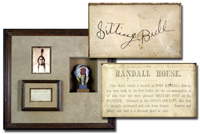 |
Sitting Bull (Tatanka-Iyotanka) (born c. 1831 to 1834, died 1890) Legendary American Indian leader, born near Grand River, South Dakota, member of Junkpapa Sioux tribe; became head chief of the entire Sioux nation c. 1867. When the Fort Laramie Treaty of 1868 was set aside to allow white settlement in the Black Hills and the commissioner of Indian Affairs decreed that all Lakota not settled on reservations by January 31, 1876 would be considered hostile, Sitting Bull summoned the Lakota, Cheyenne and Arapaho to defend their land. On June 25, 1876, Indian forces led by Oglala Lakota war chief Crazy Horse were attacked by the Seventh Cavalry under General George Armstrong Custer at the Battle of the Little Big Horn. The resultant massacre caused the relentless pursuit of the Lakota, and the chiefs surrendered one by one. Sitting Bull crossed into Canada and remained defiant for four years. He came south to surrender only after he found it impossible to feed his people.
Bold Signature on the verso of a trade card for the "Randall House Location Fort Randall Dakota," 2¾"x4¾", n.p., n.d. Fine. In faint writing across the top border of the card is "G Anderson NSA Fort Randall Dakota" followed by the date Jan. 28, 1882. Since Sitting Bull was being held prisoner at Fort Randall on this date, having surrendered on July 19, 1881, it is probable that Sitting Bull signed the card for Anderson on the noted date. The card that Sitting Bull signed is a collectible in its own right, apparently distributed to encourage visitors during the Indian Wars of the 1880s and to alleviate their fears of Indian attacks. In part: "This Hotel, which has been built at Fort Randall, Dakota, has been built by the Post Trader, for the accommodation of all who visit the most pleasant military post on the frontier. Although in Indian Country, this fort is strongly garrisoned and safe from danger.…" The signed card is housed in a two-sided 7"x9" frame which is hinged to a larger 25"x27" frame, 5½" deep, which holds an image of Sitting Bull, a biography, and an 8" statue of Sitting Bull, signed "D Monfor 1935"; the latter sits in a recess and has some slight damage. The frames have several nicks that need retouching. Sitting Bull's signature is quite bold.
Estimated Value $7,000 - 9,000.
View details and enlarged photo
| Realized
$5,750 |
Lot 158 |
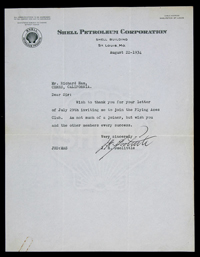 |
Doolittle, James H (1896-1993) American aviator and general; led bombing raid over Tokyo on April 18, 1942, for which he received the Medal of Honor. Typed Letter Signed "J.J. Doolittle" on Shell Petroleum Corporation letterhead, 1p, 11"x8½", St. Louis, Mo., 1934 Aug. 22. To Richard Ham in Ceres, California, thanking him for the invitation "to join the Flying Aces Club. Am not much of a joiner, but wish you and the other members every success." With transmittal envelope. One rust mark from paper clip at lower edge, else fine.
Estimated Value $250 - 300.
View details and enlarged photo
| Realized
$150 |
Lot 159 |
 |
MacArthur, Douglas & 42nd Infantry Collection. Collection of correspondence and ephemera pertaining to the 42nd Infantry ("Rainbow") Division, organized on Long Island in 1917, with Colonel Douglas MacArthur as Chief of Staff of the Division. The collection, housed in a notebook, belonged to Kenneth Sutherland, a member of the 42nd Division., secretary of the Rainbow Division Veterans, and editor of the Division's publication, "Reveille."
The jewel of this collection is a Typed Letter Signed "Doug. MacArthur" on "War Department/ Office of the Chief of Staff" letterhead, 1p, 9"x7", Washington, D.C., 1932 Aug. 19. Responding to support from members of the 42nd who had spoken out against critics of his role in the eviction of the Bonus Marchers, MacArthur writes to Sutherland: "My dear Sutherland: Thank you very much for your fine note of August 17th I appreciate it more than I can say. As you can well imagine, the situation at Washington constituted a very poignant chapter for me. When the Nation calls upon me to perform a duty there can be, of course, no question in my mind as to my complete and immediate response. It will always be a matter of unending satisfaction to me that the results were accomplished with the minimum of friction and without bloodshed. In the performance of my official duty I am indifferent to criticism, but it warms my heart indeed to know that at least some of the men with whom I fought and bled in France have appraised the situation at its true value…."
The Bonus Marchers were a group of more than 20,000 veterans from World War I who marched on Washington in the spring of 1932 to demand passage of a bill that would provide for immediate payment of their World War I bonus. A bill passed in 1924 called for every veteran to receive an additional dollar for every day served, but payment was not due for 20 years, and with the onset of the Great Depression, many of the men needed their money immediately. When the Senate defeated the bill, the marchers refused to go home, and on July 28, President Hoover ordered the army, under the command of General MacArthur, to evict them from the empty government buildings and open fields that they occupied. MacArthur ordered their camps set on fire and the army drove them out of the city. Hoover and MacArthur were much criticized for their treatment of the veterans.
Other letters in this collection are: a 1932 TLS from Major General George E. Leach in support of MacArthur's actions; a 1931 TLS with Christmas wishes from MacArthur to the men of the Rainbow Division; two 1932 letters (TlsS) to Sutherland from Father Francis P. Duffy, who served as 1st Lt. and chaplain of the legendary 69th Infantry (part of the 42nd Div.), a 1935 TLS to Sutherland from French General Henri Gouraud (commander of the French Fourth Army on the Western Front during WWI), enclosing a photo (signed by Gouraud) of himself with MacArthur; a 1931 TLS from poet Burr McIntosh, enclosing a re-worked version of his poem, "The Doughboy"; and a 1933 TLS on New Yorker letterhead from author Alexander Woollcott regarding a transcript of a Father Duffy broadcast.
Ephemera includes: a silk 11 ½"x17 ½" 48-star flag with a 1924 booklet on flag etiquette; various items for Rainbow Veterans' events, a 10 �"x8" piece of leather (from a courier bag?) stamped "42", and a booklet with organizational and divisional insignia of the A.E.F. during WWI.
Estimated Value $2,500 - 5,000.
View details and enlarged photo
| Realized
$1,725 |
Lot 160 |
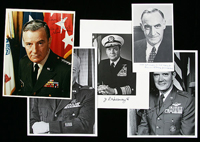 |
(Military Leaders - Five). Photographs Signed with rank by Generals H.S. Vandenberg, Lucius Clay, and Henry Miley; Clay and Miley added inscriptions. Also, Admiral J.L. Holloway and Barney Oldfield (USAF Col. who was press aide to Gen. Eisenhower). Four are B&W (Miley's is color); all are 10"x8", except Clay's, which is 7¾"x4¾". All fine.
Estimated Value $200 - 300.
View details and enlarged photo
| Unsold |
Lot 161 |
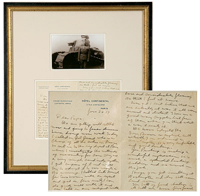 |
Patton, George S (1885-1945) American general and tank commander, known as "Old Blood and Guts"; considered one of the greatest military leaders in history. Autograph Letter Signed "George S. Patton Jr." on Hôtel Continental stationery, 4pp, 7"x5¼", Paris, France, 1917 June 20. Fine; pp 3 and 4 are written horizontally as one page. To "Dear Papa," less than two and a half months after the United States entered World War I. Patton, who had served as acting aide to Gen. John J. Pershing in 1916, during the Mexican expedition, was taken to France with Pershing as commander of his headquarters troops. In November 1917, Patton was detailed to the newly-established Tank Corps of the U.S. Army and assigned the task of organizing and training the 1st Tank Brigade. In mid-September 1918, he led his unit in the St. Mihiel drive and, in late September, was wounded at the opening of the Meuse-Argonne offensive. He was awarded the Distinguished Service Cross and Distinguished Service Medal.
In part: "We are getting well settled now….Today I called on Genl. Gerard who is in charge of all the autos in France. He sent me to the big depot at Paris where I investigated the methods of accounting for cars. They use a very simple card index system. I got copies of it and will try to adapt it to our needs….I talked Auto French for two hours with an expert…I can do quite well…can talk on any subject with ease….Even yet I can't believe that we are actually at war it all seems unreal and distant. There are a good many cripples but few of them when you think what a war it really is. We have adopted the Sam Brown or English belt….It is very comfortable and good looking. Gen. Pershing is making a wonderful impression. He is such a splendid looking soldier and so much on the job….The talk of food shortage is all talk we have fine food and plenty of it and in fact it costs less than in Washington…." He adds a paragraph giving instructions about breeding his horses and closes, "I am very well and doing fine give my love to all. Your devoted son. George S. Patton Jr."
Estimated Value $6,000 - 8,000.
View details and enlarged photo
| Unsold |
Lot 162 |
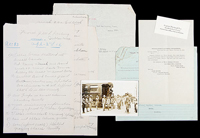 |
1916 Mexican Border War (Punitive Expedition). Notebook of approximately 150 pages kept by Captain Fitzhugh Lee, Aide-de-Camp to Maj. Gen. Funston, containing a detailed day-to-day account of the 1916 Mexican Border War. Some one hundred pages pertain to the Punitive Expedition; the remainder deals with Lee's career as Col. commanding the 7th Cavalry, up to 1927. The pages include General Orders, telegrams between Funston and the War Department, to Gen. John Pershing, who headed the Expedition ("Hostilities have begun…Take same action as if you had been attacked"), and between the War Dept. and Maj. Gen. Hugh L. Scott, Chief of Staff of the Army. It also includes 38 pages of notes in Lee's hand of day-to-day reports on Pershing's movements, and typewritten synopses of military actions, as well as notes that Lee took to a May 2nd conference between Gen. Obregon, Funston, and Scott regarding the "dis-occupation of Mexican territory by American troops." There are also typed charts and lists, such as the names of Americans killed from Mar. 9-May 25, and a May 15th mention that "Detachment under Lieut. Patton…while at Rubio…was fired on by Mexicans" (this was the famous incident in which Patton shot Gen. Cardenas and lashed him and two other dead Villa subordinates to the fender of his car as a trophy). Lists giving the breakdown of numerous provisional divisions and two separate brigades, and a memo shows the status of National Guard organizations in the Southern Dept. A fascinating, inside look at the events of the Punitive Expedition.
The communications are very detailed, with precise times and troop movements. A few of Lee's notes: (Mar. 15) "Gen'l Pershing Reports: Columbus / Columns crossed Border" (Mar. 28) "…Villa trail not yet located" (Mar 30) "Dodd struck Villa…at Guerrero. Villa dead….Carranzista troops being held for execution were liberated…" (Mar. 31) "Only 2 Aero's can reach altitude 2000 ft…not sufficient for scouting duty…" (Apr. 2) "misleading information being spread by Villa sympathizers…can not obtain reliable guides…" Instructions from War Dept. to Maj. Gen. Scott include: (Apr. 26) "…meet Gen. Obregon and discuss…future military operations…avoid…appearance of intervention in the domestic affairs of the Republic of Mexico…" (May 1) "…in case matters come to open break telegraph 'Send them at once.'" War Dept. to Funston: (July 2) "The Government in Washington has a very definite policy…to force the Mexicans…to evacuate the widest possible strip of their territory from the border south. The foregoing must be distinctly understood by you and be your guide of action."
The Mexican Border War of 1916, or Punitive Expedition, was the American reaction to a March 9th raid on Columbus, New Mexico by Pancho Villa. The American government doubted that Mexican president Carranza had the power to hunt Villa down, and Maj. Gen. Frederick Funston, a Congressional Medal of Honor winner from the Spanish American War (stationed at Fort Sam Houston), wired Washington recommending a pursuit of Villa; he received a go-ahead from Secretary of War Newton D. Baker on March 10. On March 13, Mexican General Alvaro Obregon, Mexican Secretary of War, issued a telegram outlining an agreement between the two governments permitting them to cross the border "in pursuit of bandits who are committing depredations along our frontier." General Orders No. 1, published on March 14, 1916, organized the Punitive Expedition, headed by Gen. John Pershing. The forces were ordered home in January 1917, having failed to capture Villa but with experience that would serve them well in World War I.
Estimated Value $2,500 - 5,000.
View details and enlarged photo
| Realized
$2,415 |
Lot 163 |
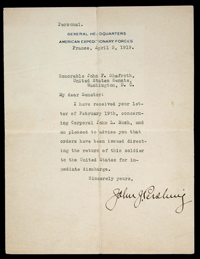 |
Pershing, John J (1860-1948) Commander-in-Chief of the American Expedtionary Forces in World War I. Typed Letter Signed as Commander-in-Chief, on official letterhead, 1p with blank integral leaf, 8¾"x6¾", France, 1919 Apr. 3. Very good; light toning and folds. Marked "Personal" to Senator John F. Shafroth, regarding corporal John L. Rush. In part: "…orders have been issued directing the return of this soldier to the United States for immediatre discharge." Bold signature.
Estimated Value $400 - 600.
View details and enlarged photo
| Realized
$259 |
|
|